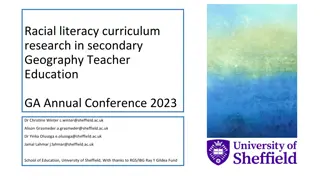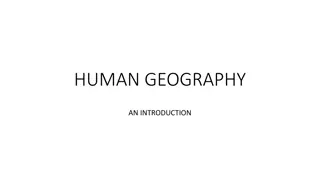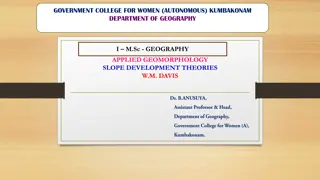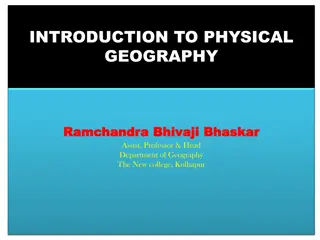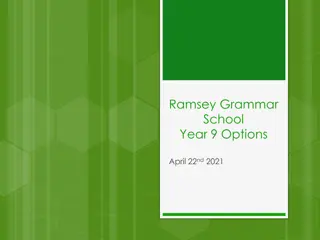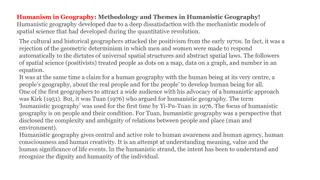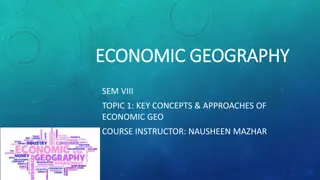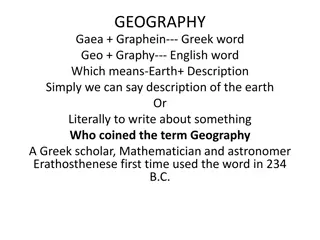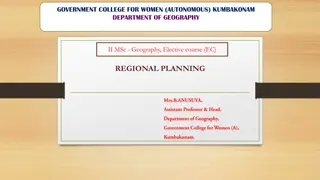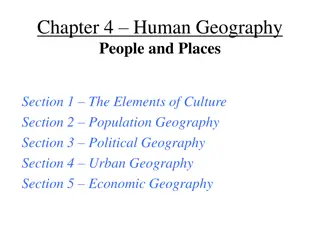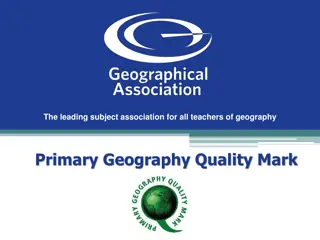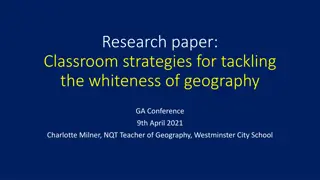Introduction to Geography
Explore the intricate relationship between language, culture, and geography in Chapter 7 of "Introduction to Geography: People, Places, and Environment." Delve into the significance of languages, dialects, and religions as defining factors of human cultures, along with the role of language development and linguistic geography in shaping our world.
Download Presentation

Please find below an Image/Link to download the presentation.
The content on the website is provided AS IS for your information and personal use only. It may not be sold, licensed, or shared on other websites without obtaining consent from the author.If you encounter any issues during the download, it is possible that the publisher has removed the file from their server.
You are allowed to download the files provided on this website for personal or commercial use, subject to the condition that they are used lawfully. All files are the property of their respective owners.
The content on the website is provided AS IS for your information and personal use only. It may not be sold, licensed, or shared on other websites without obtaining consent from the author.
E N D
Presentation Transcript
Introduction to Geography People, Places, and Environment, 3e Edward F. Bergman William H. Renwick Chapter 7: The Geography of Languages and Religions Holly Barcus, Morehead State University And Joe Naumann, UMSL
Language & Religion Two most important forces that bond and define human cultures Two most important factors defining culture regions 2
Defining Language Pronunciation and combination of words used to communicate within a group of people Important cultural index Structures individual perception of world 3
Language Regions Dialects Minor variations within a language Standard language Following formal rule of diction and grammar Official language Primary language for any given country Defacto or Dejure? Lingua franca Current language of international discourse 4
Linguistic Geography The study of different dialects across space Speech community a group of people who speak together Isoglosses Frequently parallel physical landscape features Geographical dialect continuum 5
Worlds Major Languages 3,000 distinct languages 50% of world population speak one of 12 major languages listed Mandarin Chinese is largest with 885 million English is the primary language of 350 million and is the official language of about 50 countries 7
Language Development Protolanguage Common ancestor to any group of today s languages Language family Languages related by descent from a common protolanguage Members of the same language family may not be mutually intelligible Cognates words related somewhat like cousins i.e. reign or royal (English) & Rajah (Hindi) Etymology study of word origins 10
Indo-European Language Family Identified by Sir William Jones, 1786 Proto-Indo-European Common ancestor of many modern languages Grimm s Law Set forth by Jacob Grimm of the Brothers Grimm Accounts for sound shifts as language family differentiated. 11
Indo-European Hearth? Hearth in vicinity of Turkey (Anatolia) Likely diffusion routes 13
Geography of Writing Orthography has spatial characteristics System of writing Sumerians Olmec Alphabets Roman Cyrillic Arabic Sometimes the same spoken language is written in different scripts Non-alphabetic - pictographic Chinese, Japanese, Korean 15
The same spoken language but different scripts Related script
Toponymy The study of place names Consists of: Natural features Origins/values of inhabitants Belief structures, religions Current or past heroes 18
Political Change & Name Change
Linguistic Differentiation National languages Imposed or encouraged by government with varying success De facto or de jure Nation building Philological nationalism Belief that mother tongues have given birth to nations. Postcolonial societies Imposed official languages by colonial ruler Not spoken by locals 21
Multiple Language States Polyglot states Having multiple official languages Can promote political devolution United States English always lingua franca Three major dialects in 13 colonies Non-English languages English is de facto official language, not de jure 22
Worlds Major Religions Systems of beliefs guiding behavior Orthopraxy (correctness of action or practice) Behavior oriented Orthodoxy ( correctness of belief or verbal expression) Theological/philosophical Fundamentalism -- the strict maintenance of the ancient or essential doctrines of any religion or ideology. Secularism -- a philosophy or world view that stresses human values without reference to religion or spirituality 24
Religions Classification and Distribution of Religions Universalizing: Christianity, Islam, Buddhism all proselytize Christianity is the most widespread In Africa, Islam is the fastest growing In SubSaharan Africa - Christianity Ethnic: Judaism, Hinduism, Shintoism Tribal (traditional) small-size ethnic 25
Judaism 28
Judaism 14 million adherents Monotheistic (claims to the oldest one) Based on covenant with Abraham Scriptures: Torah 5 books of the Law Genesis, Exodus, Leviticus, Numbers, Deuteronomy Sects Orthodox, Conservative, Reform Israel More Jews in New York City than in Isreal Homeland for Jewish people Created 1948 Conflict between Israel and Palestine 29
Jewish Worship Synagogue came into existence during exile after the temple, which had previously been the center of worship, had been destroyed and many Jews had been taken to Babylon as captives. 30
Christianity 31
Christianity Emerged from Judaism Jesus was a Jew! Coptic Church Founded in Alexandria in CE 41 Still present in Egypt and Ethiopia Official religion of Roman Empire 312 CE Facilitated geographical spread Model for its bureaucratic structure Split with Eastern Orthodox 11thcentury CE Dark Ages preserver of European culture Protestant Reformation 1517 CE Significant growth in Africa, Asia and Latin America 32
Christian Fundamentals Areas of almost complete agreement Sacraments of Baptism & Matrimony Monotheism involving one God in a trinity of persons (referred to as a mystery) Blessing and sharing bread and wine at least in memory of Jesus sacrifice Jesus was/is 100% God and 100% human Salvation comes from belief in and acceptance of Jesus as one s savior There will be a second coming at the end of time 33
Christian Denominations Coptic Eastern Orthodox Greek, Serbian, Russian, Armenian, etc. Roman Catholic Latin Rite & Greek Rite Largest single denomination in the USA Protestant hundreds of denominations Luther, Calvin, Zwingli, etc. Peripheral significant differences from the mainstream Christian denominations Mormon, Jehova Witnesses, etc. 34
Islam 35
Islam Muhammad the final prophet 622 CE Allah (word for God) Monotheistic Major Sects: Sunni 85% and Shiite 15% Koran is sufficient to direct all aspects of life No clergy or building required Jews & Christians people of the book 36
Five Pillars Five Pillars of Islam Belief in one God Five daily prayers facing Mecca Generous alms (help to poor) Fasting during the holy month of Ramadan Pilgrimage to Mecca (hajj) 37
Hinduism 38
Hinduism Hinduism Most ancient religious tradition in Asia (world?) Vedas Hindu sacred texts May be viewed as monothestic Castes Brahman, priestly Kshatriya, warrior/ruler Vaisya, tradesman and farmer Sudra, servant and laborer Untouchables (de facto 5thcaste) Central belief is in reincarnation Transmigration of the soul Cycles of creation birth to death to birth Role of dharma & karma Effect on diet 39
Characteristics of Hinduism No clergy or religious requirements No real splintering or sects Can be practices in many ways & at many levels so there was no need to split off. No concept of a personal God Each individual is seeking to comprehend the ultimate reality while living out his/her dharma with the goal of union with Brahman once the cycle of reincarnation is ended. 40
Monotheism? 41
Sikhism 42
Sikhism Sikhism (attempt to reconcile Islam & Hinduism) Offshoot of Hinduism Centered around the Punjab area Guru Nanak 43
Buddhism 44
Buddhism Siddhartha Gautama Kshatriya Caste Buddha Enlightened One Four Noble Truths Life involves suffering Cause of suffering is desire Elimination of desire ends suffering Right thinking and behavior eliminate desire Diffused from India 45
Buddhism Nirvana Buddhism is a way of living that achieves release from reincarnation and suffering God is not knowable, so is, therefore, not a major concern in Buddhism Buddha (Siddhartha Gautama) rejected the caste system 46
Buddhism Scriptures: Vinaya (discipline) expanded later Branches: Theravada (south) monk seeks own deliverance Mahayana (north) role of bodhisattvas & ritual Tibetan Lamaism example of syncretism 47
The Eight-Fold Path The Way (the 8- Fold Path) The threefold scheme of morality 1. Right understanding 2. Right thought Faith (initially) Wisdom: III (ultimately) 3. Right speech 4. Right bodily action 5. Right livelihood Morality: I 6. Right moral effort 7. Right mindfulness 8. Right concentration Meditation: II 49
Other Religions Eastern Religions Confucianism China Taoism China Shinto Japan Zoroastrianism Iran Baha'i Iran Animism and Shamanism Animism Belief in influence of spirits or spiritual forces in all creation Shamanism Shaman 50




